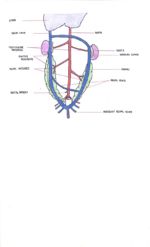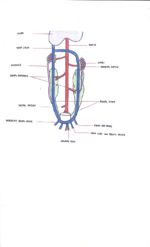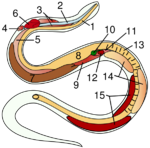Difference between revisions of "Snake and Lizard Reproduction - Anatomy & Physiology"
Jump to navigation
Jump to search
| Line 153: | Line 153: | ||
[[Category:Exotic Reproduction]] | [[Category:Exotic Reproduction]] | ||
| − | |||
Revision as of 18:11, 29 November 2010
Lizards (Squamata)
Male
Testes
- Located cranial to the kidneys.
- Attached to the dorsal wall by a mesochorium.
- In some species, the kidney has a posterior sexual segment that becomes swollen during the breeding season and contributes to seminal fluid.
- Right testis lies cranial to the left.
- Intimately connected to the vena cava by short blood vessels.
- Left testis lies close to the adrenal gland.
- Has its own testicular blood vessels.
Phallus
- Paired hemipenes
- Stored in the base of the tail.
- Visualised externally by bulges at the ventral proximal tail.
- Only one hemipene is used during copulation.
- Erected by vascular engorgement and muscular action.
- Everted to protrude through the cloaca.
- Sperm passes from the ductus deferens into the male urodeum.
- Sperm is then carried in a groove down the hemipene to be deposited in the female cloaca.
Female
Ovary
- Paired
- Consists of a cluster of oocytes lined by a thin mesovarium.
- Right ovary is close to the vena cava.
- Attached to vena cava by tiny blood vessels.
- Left ovary lies close to the left adrenal gland.
- Has its own ovarian blood supply.
Oviduct
- Paired
- Pleated
- Wide infundibulum
Oviparity
This is the usual state for lizards, including all Geckos and Iguanas.
- Eggs are retained within the mother until birth.
- Normal clutch size is 3-5.
- Eggs covered by a leathery shell
- Can appear shrunken when laid.
Viviparity
About 1/5 of lizards are viviparous including the common European Lizard.
- Foetus retained within the oviduct.
- Primative placental type of circulation.
Breeding Season
Temperate Species
- Gonads reach maximum size on emergence from hibernation.
- Gonads are smallest during the summer months.
Tropical Species
- Breeding season coincides with the start of the wet season.
- Moisture for egg incubation.
- Abundant food supply for hatchlings.
Snakes (Squamata Serpentes/Ophidia)
Sexual Maturity
- Smaller species can reach sexual maturity in 1 year.
- Larger, more long-lived species may not be sexually mature until 5 years of age.
Male
Testes
- Intra-abdominal
- Situated between the pancreas and the kidneys.
Phallus
- Two hemipenes
- Paired, sac-like extensions of the cloaca.
- Lie within the ventral tail base.
- Each hemipene has a retractor muscle that extends from the tail vertebrae to the tip and sides of the hemipene.
- Large glands lie above the hemipenes.
- Hemipene retractor muscle and anal glands are all surrounded by a larger propulsor muscle.
- When the hemipene is engorged with blood, the propulsor muscle contracts.
- Everts the hemipene.
- After engorgement has subsided, the retractor muscle contracts.
- Inverts the hemipene.
Female
Female snakes can be oviparous, or viviparous.
Ovary
- Paired
- Located asymmetrically near the pancreas.
- Right oovary usually larger and more cranial.
- Left ovary may be reduced or undeveloped.
Sperm Storage
- Some female snakes can store sperm in a cavity lined by mucosa glands near the top of the oviduct.
- Stored here until conditions are right.
- Can be stored for months or even years.
- Thus snakes may suddenly appear fertile in abscence of a male.
Maternal Behaviour
The Indian Python is the only reptile to exibit maternal behaviour. This can be achieved owing to her large body size.
- Generate a 7ºC increase in heat by spasmodic contractions of muscles as they coil around the eggs.
- Coil tightly around the egg mass to prevent heat loss from the eggs.
- Unlike mammalian shivering, the muscle contractions are coordinated.
- Metabolic rate of the mother increases 20-fold.
Breeding Season
Temperate and Subtropical Species
- Breeding season is in Spring.
Tropical Species
- Breed at the start of the wet season.
- Ideal climate for egg incubation.
Copulation
- Male initates courtship by moving his body over the female and rubbing his tail against her.
- If female is receptive, she dilates her cloaca and raises her tail.
- Copulation lasts 2-20 hours.
- During copulation one hemipene is evaginated and inserted into the female cloaca.
- Hemipene has spines and ridges that enable it to remain in the cloaca for a long period of time.
- Hemipene is withdrawn at the end of copulation by contraction of the retractor muscle.
- During multiple mating, the male can use the left and right hemipene alternately.




